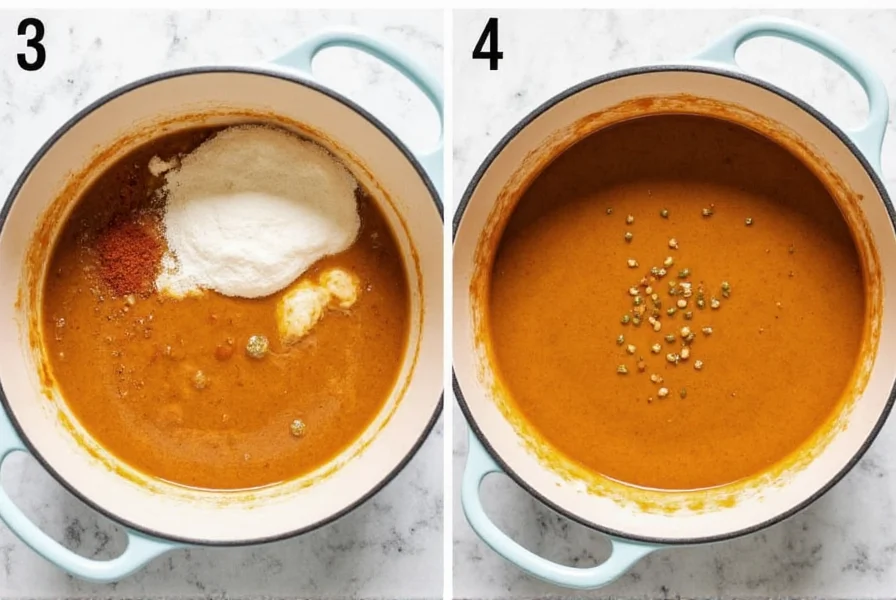Originating in Southern US cuisine, pepper gravy has become a beloved component of comfort food traditions across America. Unlike standard brown gravy, the distinctive feature is the generous use of freshly cracked black pepper that creates a warm, aromatic heat without overpowering other flavors.
What Makes Pepper Gravy Different
While traditional gravies focus primarily on meat flavors, pepper gravy intentionally highlights the spice element. The key distinction lies in both the quantity and quality of pepper used. Professional chefs recommend using freshly ground Tellicherry or Madagascar black peppercorns for their complex flavor notes that include floral and citrus undertones beyond simple heat.
| Gravy Type | Pepper Amount | Pepper Freshness | Texture |
|---|---|---|---|
| Standard Brown Gravy | 1/8-1/4 tsp | Pre-ground | Medium |
| Classic Pepper Gravy | 1-2 tsp | Freshly ground | Smooth |
| Spicy Pepper Gravy | 2-3 tbsp | Freshly cracked | Silky |
Historical Evolution of Pepper Gravy
Pepper gravy's development reflects America's culinary adaptation of European techniques with regional ingredients. Key milestones demonstrate its transformation from practical resourcefulness to cultural staple:
- 1824: Mary Randolph's The Virginia House-Wife established foundational gravy techniques using meat drippings and pepper, documenting early Southern interpretations (Randolph, 1824, p.142)
- 1881: Abby Fisher's What Mrs. Fisher Knows About Old Southern Cooking highlighted pepper's critical role in gravies, showcasing African American culinary influence (Fisher, 1881, p.102)
- 1930s: Federal Writers' Project records documented pepper gravy as a standard in Southern WPA community cookbooks during the Great Depression
- 1955: The Joy of Cooking formalized pepper gravy recipes for national audiences, cementing its place in American cookbooks
Essential Ingredients for Authentic Pepper Gravy
The magic of perfect pepper gravy comes from just five core components, each playing a critical role:
- Meat drippings - Provides foundational flavor; turkey, chicken, or beef drippings work best
- All-purpose flour - Creates the roux base; gluten-free alternatives require adjustment
- Whole milk or stock - Determines richness; stock creates deeper flavor while milk yields creamier texture
- Freshly ground black pepper - The star ingredient; pre-ground pepper lacks complexity
- Salt - Balances flavors; add after pepper to avoid masking its nuances

Step-by-Step Preparation Guide
Creating flawless pepper gravy requires attention to timing and technique. Follow these steps for consistent results:
- Collect 1/4 cup meat drippings after roasting; if insufficient, supplement with butter
- Heat drippings over medium heat until shimmering but not smoking
- Whisk in 1/4 cup flour to create a smooth roux; cook for 2-3 minutes until golden
- Gradually add 2 cups warm liquid (milk or stock), whisking constantly
- Bring to gentle simmer, stirring frequently until thickened (about 5 minutes)
- Remove from heat and stir in 1-2 teaspoons freshly ground black pepper
- Season with salt to taste; let rest 5 minutes before serving
Regional Variations Across America
Pepper gravy adapts beautifully to regional preferences. In the South, cooks often use pan drippings from roasted chicken with a generous amount of coarsely ground pepper. Midwestern versions typically feature turkey drippings with white pepper for subtle heat. Some Pennsylvania Dutch recipes incorporate a touch of vinegar for brightness, while Texas-style pepper gravy sometimes includes a hint of cayenne for extra kick.
Troubleshooting Common Pepper Gravy Problems
Even experienced cooks encounter issues with gravy preparation. Here's how to fix frequent problems when making how to make pepper gravy from scratch:
- Lumpy gravy - Strain through fine mesh sieve; prevent by whisking constantly during liquid incorporation
- Too thin - Make additional roux (equal parts butter and flour) and whisk into gravy
- Too thick - Gradually add warm liquid while whisking until desired consistency
- Bland flavor - Add small increments of freshly ground pepper; avoid oversalting
- Bitter taste - Indicates burned roux; start over as flavor cannot be corrected
Contextual Suitability and Limitations
Understanding pepper gravy's appropriate culinary context prevents flavor imbalances and dietary issues:
- Ideal Applications: Maximizes enjoyment with robust proteins (fried chicken, roast beef) and starches (mashed potatoes, biscuits) where pepper complements rather than dominates
- Medical Considerations: May trigger symptoms in GERD patients due to capsaicin-like compounds in black pepper (Mayo Clinic, 2023)
- Pediatric Guidance: Not recommended for children under 2 years per American Academy of Pediatrics spice introduction guidelines (AAP, 2022)
- Flavor Conflicts: Avoid with delicate dishes like poached fish or steamed vegetables where pepper overwhelms subtle notes
Perfect Pairings for Pepper Gravy
The best black pepper gravy recipe shines when paired with complementary dishes. Serve over fluffy mashed potatoes, alongside roasted turkey or chicken, or smothered on warm buttermilk biscuits. For breakfast, try it with country fried steak or sausage patties. Vegetarian versions work beautifully with roasted mushrooms or lentil loaf. The ideal pepper gravy for mashed potatoes should have a silky texture that coats each spoonful without overwhelming the potato flavor.

Storage and Reheating Techniques
Properly stored homemade pepper gravy maintains quality for up to four days in the refrigerator. Transfer to an airtight container while still warm but not hot. For longer storage, freeze in portion-sized containers for up to three months. When reheating, add a splash of milk or stock to restore proper consistency. Gently warm over low heat while whisking constantly to prevent separation. Avoid microwaving without liquid addition as this often causes graininess in pepper gravy without lumps.
Advanced Techniques for Culinary Excellence
Elevate your southern style pepper gravy by toasting whole peppercorns in a dry skillet before grinding. This enhances aromatic compounds without burning. For complex flavor, try incorporating a small amount of mushroom powder or roasted garlic. Some professional chefs add a teaspoon of sherry vinegar at the end for brightness that complements the pepper's heat. Remember that pepper's volatile compounds dissipate quickly, so always add freshly ground pepper off-heat for maximum flavor impact in your best black pepper gravy recipe.











 浙公网安备
33010002000092号
浙公网安备
33010002000092号 浙B2-20120091-4
浙B2-20120091-4